[vc_row css=”.vc_custom_1431670008004{margin-bottom: 20px !important;}” parallax_speed=”0.3″][vc_column width=”1/4″ offset=”vc_hidden-sm vc_hidden-xs”][stm_sidebar sidebar=”801″][/vc_column][vc_column css=”.vc_custom_1431070716473{padding-left: 45px !important;}” el_class=”right_column” offset=”vc_col-lg-9 vc_col-md-9″][vc_row_inner css=”.vc_custom_1476746276340{padding-bottom: 35px !important;}”][vc_column_inner][vc_column_text]
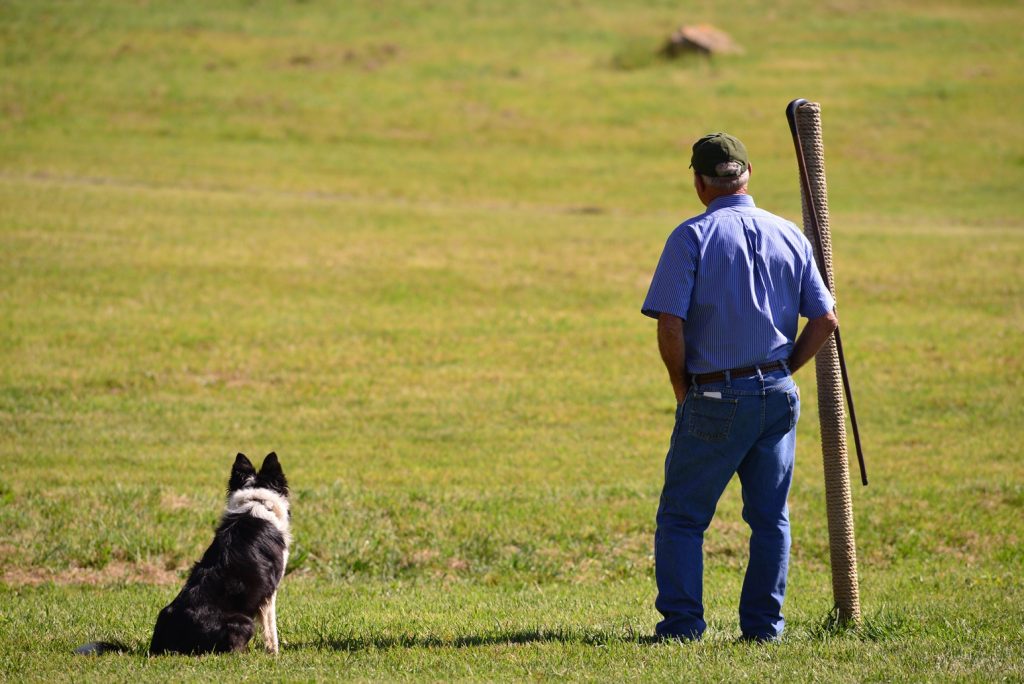
Photo courtesy of Paul Turner, Ripplecreekphoto.com 2016
Course Description
The following description is intended as a general guideline only. The number of sheep used in the semi-final and final runs, the number of shed sheep or the course pattern may change.
The handler must adjust to these changes as well as other variables such as the weather, sheep temperament and condition, terrain, altitude and time of day.
Object – The object of a trial course is to test the dog’s ability to manage/maneuver sheep in a clam, controlled manner.
Components of the Course – There are six scored components of a sheepdog trial course; outrun, lift, fetch, drive, shed and pen.
Each dog and handler start their run with full points and the judge makes point deductions throughout the run for errors and deviations from the prescribed course.
A time limit is set for each round, and once time is elapsed, the handler can only be scored on the retained points until time elapsed.
There is no point advantage to finishing quickly, but handlers keep a close watch on time so that they can pace their run.[/vc_column_text][/vc_column_inner][/vc_row_inner][vc_row_inner css=”.vc_custom_1476746300107{padding-bottom: 35px !important;}”][vc_column_inner][vc_column_text]
COMPONENTS, TIMES & POINTS FOR THE COURSE
[/vc_column_text][vc_table vc_table_theme=”classic_green”][borders_all]Preliminary%20Round,[borders_all]Semi-Final%20Round,[borders_all;b]Double%20Lift%20Finals|[borders_all;align-left]100%20Points,[borders_all;align-left]110%20Points,[borders_all;align-left]170%20Points|[borders_all]5%20Sheep%2Frun,[borders_all]5%20Sheep%2Frun,[borders_all]20%20Sheep%2FRun%20(2%20groups%20of%2010%20sheep)|[borders_all]130%20Dogs,[borders_all]30%20Dogs%20Qualify,[borders_all]12%20Dogs%20Qualify|[borders_all]13%20Minutes,[borders_all]17%20Minutes%20(approx),[borders_all]30%20Minutes%20(approx)|Outrun%2C%2020%20points,Outrun%2C%2020%20points,1st%20Outrun%2C%2020%20points%20%20%20%20%20%202nd%20Outrun%2C%2020%20points|Lift%2C%2010%20points,Lift%2C%2010%20points,1st%20Lift%2C%2010%20points%20%20%20-%202nd%20Lift%2C%2010%20points|Fetch%2C%2020%20points,Fetch%2C%2020%20points,1st%20Fetch%2C%2020%20points%2C%20-%202nd%20Fetch%2C%2020%20points|Drive%2C%2030%20points,Drive%2C%2030%20points,Drive%2C%2040%20points|Shed%2C%2010%20points,Shed%2C%2010%20points,Shed%2C%2020%20points|Pen%2C%2010%20points,Pen%2C%2010%20points,Pen%2C%2010%20points|,Single%20Shed%2C%2010%20points,[/vc_table][/vc_column_inner][vc_column_inner][/vc_column_inner][/vc_row_inner][vc_column_text]
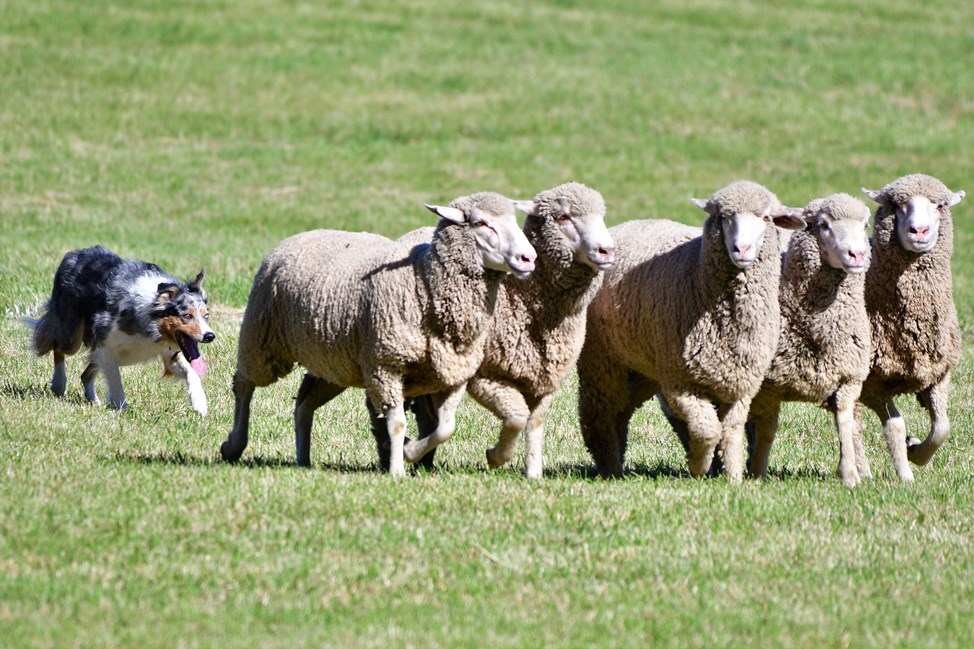
The object is to test the dog’s ability to manage/maneuver sheep in a calm, controlled manner. – photo courtesy of Paul Turner 2016
The Meeker Classic allows 170 dogs to enter and run in the preliminary round which takes 4 days to complete (Tuesday, Wednesday, Thursday and Friday). The top 30 preliminary scores qualify for the semi-final round on Saturday, where an additional element (single shed) is added to the prescribed course. The top 12 dogs from Saturday qualify for the Double Lift Final on Sunday.
OUTRUN, 20 points
The outrun is the first phase of the trial course. Dog and handler take their place at the handler’s post, where the dog must remain until sent 500 yards for the sheep. Once the sheep are in place at the far end of the field, and the dog is sent, the run and the clock start. The handler may send the dog either to the left or the right. The outrun should be a “pear shaped” with the blunt end of the pear at the far end of the field behind the sheep. A successful outrun is completed when the dog has circled around behind the sheep without disturbing them.

The Lift – after the sheep has been set- the dog makes the outrun and lifts them from where they’ve been set. Photo courtesy of Piper’s Pix
LIFT, 10 points
The lift is the second phase of the course, and occurs at the top end of the outrun when the dog slows down and takes control of the sheep – causing them to move. The dog’s approach to the sheep should be steady and smooth, and the dog should not “blow” the sheep apart.
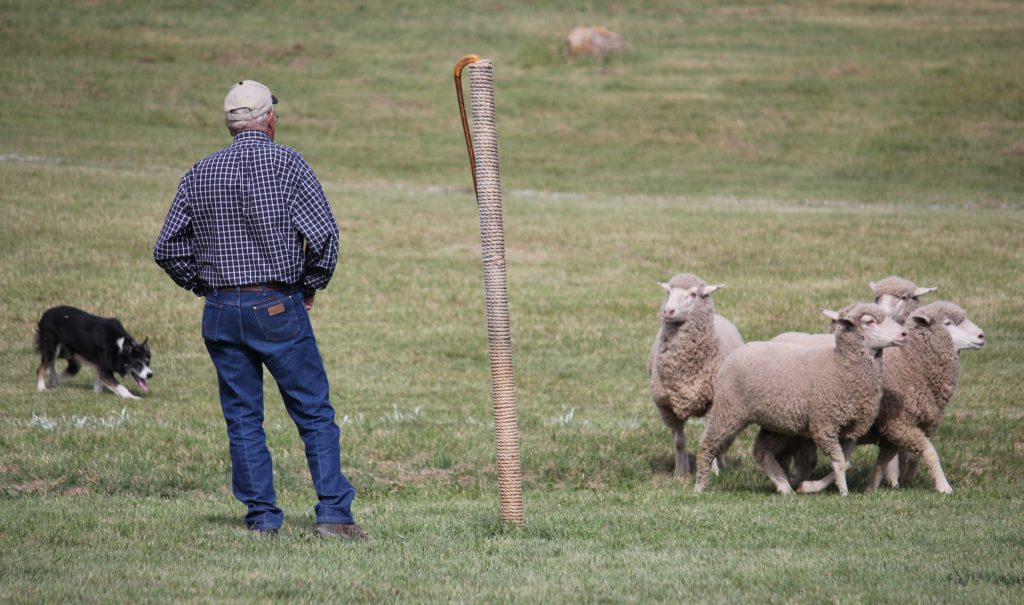
The Fetch – the dog brings the sheep through as set of panels to the handler. Here the dog is bringing them in and around the post. Photo courtesy of Dale Hallebach, DKH Productions 2016
FETCH, 20 points
During the fetch the dog brings the sheep in a straight line 500 yards through a set of fetch panels to the handler. This phase starts immediately after the lift. The sheep should be fetched at a steady controlled pace.
The dog should not hurry or over flank the sheep. Over flanking occurs when the dog goes too far on either side of the sheep, thereby turning them back and forth across the course. The result of over flanking is a zigzag pattern.
If the fetch panels are missed or the sheep are off-line point deductions are reflected. The sheep should approach the handler at the post and then pass behind the handler (direction determined by the judge) – around the post as close as practical and this should be done in a steady controlled and smooth manner.

Dog driving the sheep through the second set of drive panels – photo courtesy of Dale Hallebach, DKH Productions 2016
DRIVE, 30 points
The drive phase of the course begins immediately after the sheep pass behind the handler at the post. The dog is then required to drive the sheep away from the handler in a straight line to the first set of drive panels. The direction of the drive is pre-determined by the judge. Once the sheep are through or past the first drive panels the dog should turn them, neatly and calmly, onto a direct line across the course to the second set of drive panels/gates. Next the dog should again turn the sheep neatly and calmly and bring them in a straight line to the shedding ring.
During the drive both sets of panels are guides to the correct alignment of the sheep. The sheep should be moved at a steady pace. The drive ends in a point determined by the judge. Often this is when the sheep enter the shedding ring at which point the handler enters the ring to assist the dog.
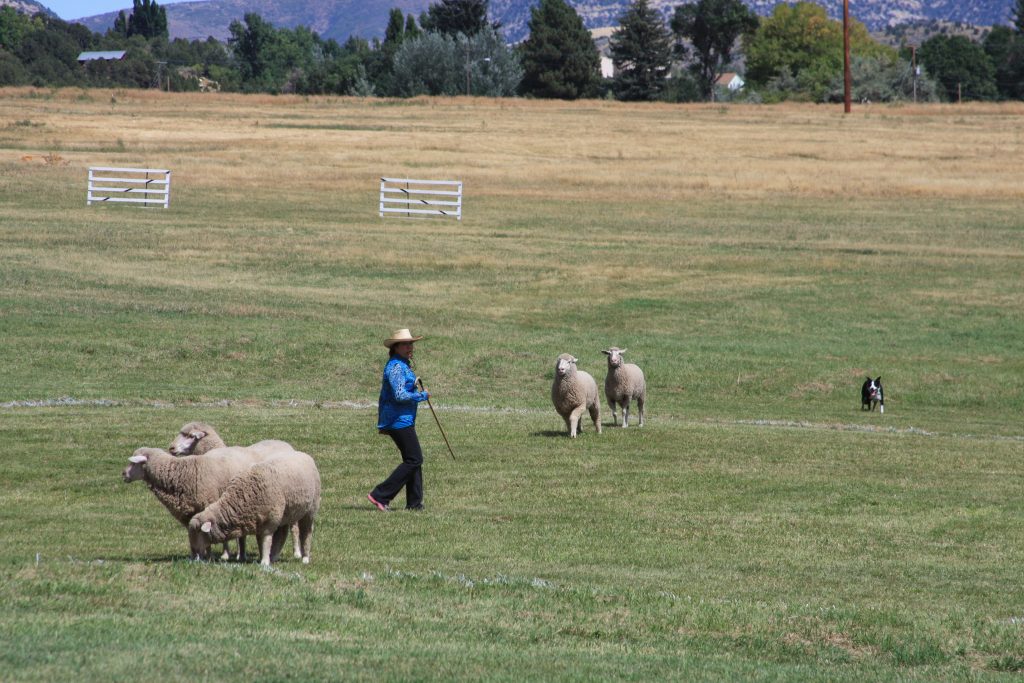
Two sheep have been shed and the dog will now bring them back to the group. Photo courtesy of Carly Thomson 2016
SHED, 10 points
The shedding ring is 120 feet in diameter and is marked on the field in front of the post. At this point the handler is allowed to leave the post to assist the dog in shedding the sheep. “Shed” means to separate two unmarked (un-collared) sheep from the rest of the flock. The ideal shed occurs when the dog comes toward the handler, through the sheep, when commanded to separate the specified 2 sheep and hold them away from the rest. The judge determines when the dog has successfully “shed” and taken control of the shed sheep and signals to the handler. After the shed is accomplished, the sheep must be regrouped inside the ring before penning.
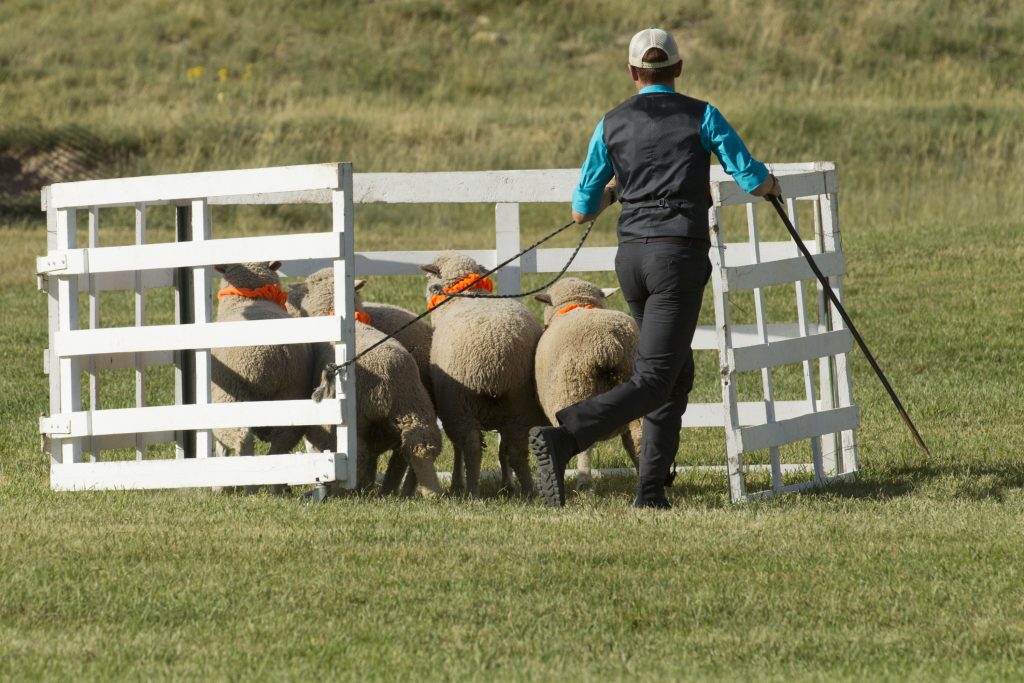
A successful pen. Photo courtesy of PiperAnne Worcester, Pipers Pix 2016
PEN, 10 points
Upon successful completion of the shed the handler then proceeds to the pen leaving his dog to bring the sheep. The pen is 6’x 9′ and has a swinging gate to which a six foot long rope is attached. The dog and handler work the sheep into the pen in a direction determined by location of the gate hinges. The handler stands at the gate holding the rope and must not let go of the rope while the dog works the sheep into the pen, at which time the handler closes the gate. After releasing the sheep the handler will close and fasten the gate and shall be penalized for failure to do so.
SINGLE SHED, 10 points (Semi-Final Round)
This difficult maneuver is usually only seen in the semi-final round of competition. After a successful pen (and time remaining), the handler will proceed back to the shedding ring, leaving the dog to bring all of the sheep. One of the two marked sheep will be shed off within the shedding ring and thereafter “worn” (inside or outside the ring) to the judge’s satisfaction.
This task is difficult because of the natural flocking instinct of the sheep. There is enormous pressure for the single sheep to return to the flock. The dog must sense and master that pressure.
DOUBLE-LIFT FINALS, 170 points
(Outrun 20, Lift 10, Fetch 20) x 2 groups, Drive 40 points, Shed 20 points, Pen 10 points
The double-lift final course involves lifting two flocks of 10 sheep each. Still set approximately 500 yards from the poste, both are situated at different locations on the field, and the dog must individually gather both flocks of sheep and unite them in the middle of the course. (Thus each outrun, lift and fetch are judged/scored independently.) The remainder of the course ensues with 20 sheep.
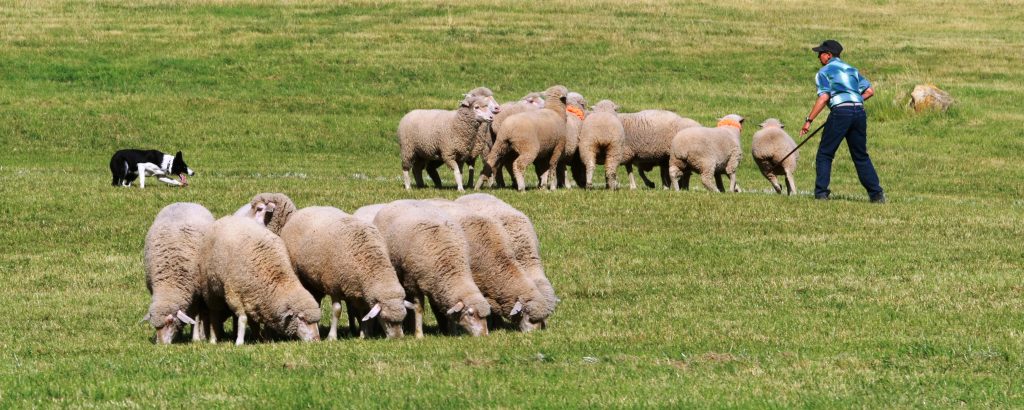
Working on the International She. Photo courtesy of Dale Hallebach, DKH Productions 2016
INTERNATIONAL SHED (Double Lift Finals)
During the shed the fifteen unmarked sheep are to be separated from the 5 marked sheep within the confines of the ring, then the five marked sheep are to be driven to the pen and penned. The unmarked sheep need not be driven out of the shed ring, but often are to avoid them mixing with the marked sheep. If one (or more) collared sheep rejoin the unmarked sheep outside the ring, the collared sheep plus the unmarked sheep it has joined must be brought back to the ring and re-shed. However, if several small groups of unmarked sheep have been shed off and are not joined, only the sheep the marked sheep has joined need to be re-gathered, not all of the unmarked sheep. The collared sheep are then penned according to general penning rules and point deductions.
[/vc_column_text][vc_row_inner css=”.vc_custom_1476746300107{padding-bottom: 35px !important;}”][vc_column_inner][vc_column_text]
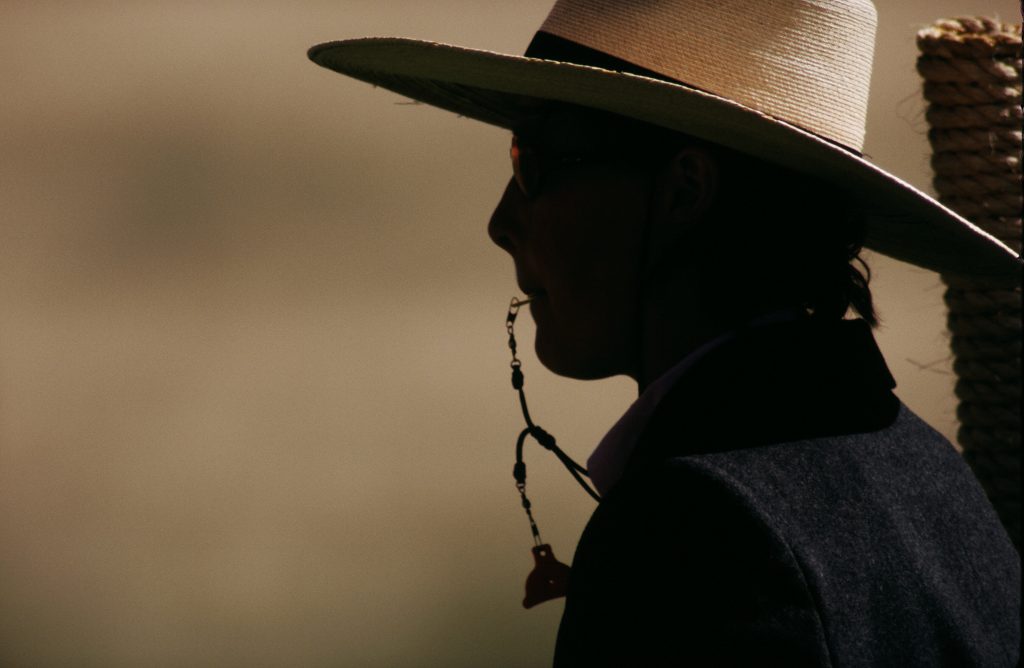
Photo courtesy of TK Inc
Words and Whistles: Stockdog Commands
Voice Commands,Whistle Commands,Explanation of Commands
[/vc_column_text][vc_table vc_table_theme=”classic_green”][b;borders_all;i]Command,[borders_all;b;i]Whistle,[borders_all;i]Desired%20Result|Lie%20Down,[border_left;border_right;border_top;border_bottom;border_left]One%20Long%20Blast%20-%20Hard%20Sharp%20tone,Stops%20Dog|That’ll%20Do,[border_left;border_right;border_bottom]Whee-Whoa-WHEE%20(Ascending%20tone),Dog%20quits%20task%20and%20comes%20to%20handler|Come%20Bye,Whe-Whoooooo%20(Descending%20tone),Dog%20moves%20left%20(clockwise)%20around%20the%20stock|Way%20to%20Me,Whee-Whooo-Wheee%20OR%20WhoooWhee%20(ascending%20tone),Dog%20moves%20right%20(counter%20clockwise)%20around%20stock|Walk%20Up,Wheet-Wheet%20(two%20short%20whistles),Dog%20walks%20directly%20towards%20the%20stock|Get%20Out,Wheet-Wheeo-Wheet-Wheeo,Dog%20turns%20sharply%20out%20%20away%20from%20stock%2C%20command%20given%20usually%20when%20the%20dog%20is%20in%20too%20tight.|Look%20Back,WWHHEE%20(humm%20%26%20blow%20at%20the%20same%20time)%20OR%20Who-Hee-Who,Dog%20looks%20back%20(to%20the%20right%20or%20left%20as%20directed)%20for%20a%20second%20group%20of%20sheep|Take%20Time,Hee-Hee-Hee-Hee,Dog%20Slows%20to%20steady%20pace%2C%20this%20command%20often%20used%20before%20or%20instead%20of%20a%20lie%20down%20command%20when%20dog%20is%20coming%20on%20too%20fast.[/vc_table][/vc_column_inner][/vc_row_inner][/vc_column][/vc_row]
